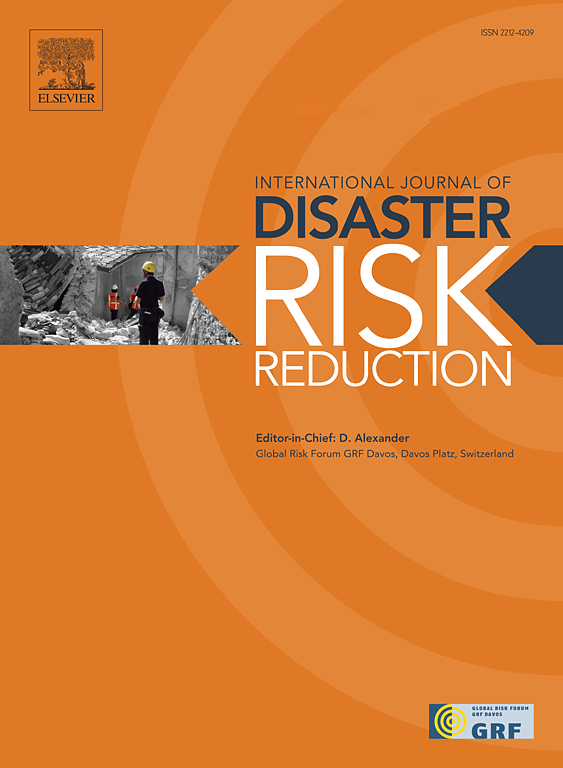Excess pneumonia and influenza mortality in Nevada during the COVID-19 pandemic (March 2020-December 2021): Implications for disaster preparedness
IF 4.2
1区 地球科学
Q1 GEOSCIENCES, MULTIDISCIPLINARY
International journal of disaster risk reduction
Pub Date : 2025-06-05
DOI:10.1016/j.ijdrr.2025.105630
引用次数: 0
Abstract
The COVID-19 pandemic disrupted pneumonia and influenza (P&I) mortality patterns, altering seasonality and increasing disparities across demographic and geographic groups. Prior studies often relied on aggregate estimates that obscured subgroup-specific disparities. This study analyzes excess P&I mortality in Nevada as a case study for pandemic-related mortality impacts through a disaster risk reduction and social determinants of health framework to quantify excess deaths, assess disparities, and evaluate COVID-19's contribution. Using death certificate data from Nevada State Vital Records spanning January 2015 to December 2021, P&I deaths were identified using ICD-10 codes (influenza: J09.0-J11.9, pneumonia: J12.0-J18.9, COVID-19: U07.1). A Zero-Inflated Negative Binomial model estimated expected P&I mortality based on pre-pandemic reference period (January 2015–February 2020), with excess deaths calculated as the difference between observed and expected mortality. Demographic and geographic disparities were quantified. Findings showed Nevada recorded 6,234 excess respiratory disease deaths, a 3.95-fold (295%) increase above expected levels. COVID-19-associated deaths comprised 75.3% of P&I deaths and 4,506 excess deaths; non-COVID-19 P&I deaths showed no significant excess. Disparities were most pronounced among males (4.33-fold, 333% increase), adults aged 25-64 (4.97-fold, 397%), and Hispanics (7.92-fold, 692%), although the greatest number of deaths occurred among adults aged ≥65. Frontier regions had the greatest mortality burden among regions (3.98-fold, 298%). These findings show the pandemic drastically impacted respiratory disease mortality patterns, disproportionately affecting working-aged adults, racial/ethnic minorities, and frontier communities. This study highlights the need for strengthened healthcare infrastructure, improved emergency response, and equitable preparedness policies.
2019冠状病毒病大流行期间(2020年3月- 2021年12月)内华达州肺炎和流感死亡率过高:对备灾的影响
COVID-19大流行破坏了肺炎和流感(P&;I)的死亡模式,改变了季节性,扩大了人口和地理群体之间的差异。先前的研究往往依赖于总体估计,掩盖了亚组特定差异。本研究通过减少灾害风险和健康的社会决定因素框架来量化超额死亡、评估差异并评估COVID-19的贡献,分析了内华达州的超额P&;I死亡率,作为大流行相关死亡率影响的案例研究。使用2015年1月至2021年12月内华达州生命记录的死亡证明数据,使用ICD-10代码(流感:J09.0-J11.9,肺炎:J12.0-J18.9, COVID-19: U07.1)确定P&;I死亡。零膨胀负二项模型根据大流行前参考期(2015年1月- 2020年2月)估计了预期的P&;I死亡率,并以观察到的死亡率与预期死亡率之差计算超额死亡率。对人口和地理差异进行量化。调查结果显示,内华达州记录了6234例呼吸系统疾病死亡,比预期水平高出3.95倍(295%)。与covid -19相关的死亡人数占I类死亡人数的75.3%,另有4506人死亡;非covid -19的死亡人数没有明显增加。差异在男性(4.33倍,增加333%)、25-64岁的成年人(4.97倍,增加397%)和西班牙裔(7.92倍,增加692%)中最为明显,尽管死亡人数最多的是年龄≥65岁的成年人。边疆地区死亡率负担最重(3.98倍,298%)。这些发现表明,大流行极大地影响了呼吸系统疾病的死亡模式,对工作年龄成年人、种族/少数民族和边境社区的影响尤为严重。这项研究强调需要加强卫生保健基础设施、改进应急反应和制定公平的备灾政策。
本文章由计算机程序翻译,如有差异,请以英文原文为准。
求助全文
约1分钟内获得全文
求助全文
来源期刊

International journal of disaster risk reduction
GEOSCIENCES, MULTIDISCIPLINARYMETEOROLOGY-METEOROLOGY & ATMOSPHERIC SCIENCES
CiteScore
8.70
自引率
18.00%
发文量
688
审稿时长
79 days
期刊介绍:
The International Journal of Disaster Risk Reduction (IJDRR) is the journal for researchers, policymakers and practitioners across diverse disciplines: earth sciences and their implications; environmental sciences; engineering; urban studies; geography; and the social sciences. IJDRR publishes fundamental and applied research, critical reviews, policy papers and case studies with a particular focus on multi-disciplinary research that aims to reduce the impact of natural, technological, social and intentional disasters. IJDRR stimulates exchange of ideas and knowledge transfer on disaster research, mitigation, adaptation, prevention and risk reduction at all geographical scales: local, national and international.
Key topics:-
-multifaceted disaster and cascading disasters
-the development of disaster risk reduction strategies and techniques
-discussion and development of effective warning and educational systems for risk management at all levels
-disasters associated with climate change
-vulnerability analysis and vulnerability trends
-emerging risks
-resilience against disasters.
The journal particularly encourages papers that approach risk from a multi-disciplinary perspective.
 求助内容:
求助内容: 应助结果提醒方式:
应助结果提醒方式:


